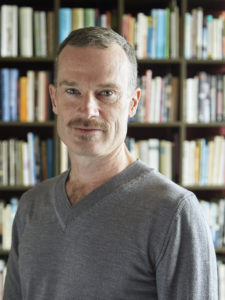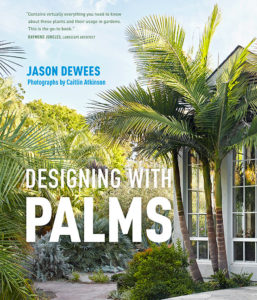 DESIGNING WITH PALMS showcases beautiful photos of gardens and native palm habitat around the country that will give you the sense of relaxing in fabulous green spaces. Author Jason Dewees will discuss creating landscapes that feature dramatic palms on Friday, April 19, at 6pm.
DESIGNING WITH PALMS showcases beautiful photos of gardens and native palm habitat around the country that will give you the sense of relaxing in fabulous green spaces. Author Jason Dewees will discuss creating landscapes that feature dramatic palms on Friday, April 19, at 6pm.
Prior to his talk, we had the opportunity to ask him a few questions:
Q: What inspired you to write this book? Why palms?
 A: I became the youngest member at the time of the International Palm Society in high school and maintained the interest until I began working in horticulture and eventually at Flora Grubb Gardens, a design-driven garden center in San Francisco where palms are a significant offering — big specimens, small rarities, and everything in between. Palms are exceptional plants, charismatic, iconic, and diverse — and not always the easiest to understand and work with. Much of my work as horticulturist at Flora Grubb Gardens involves collaborating with designers, homeowners, and landscape architects on planting design, and it became clear that there was a place for a book about designing with palms, something of interest to gardeners, designers, and palm-lovers. Once photographer Caitlin Atkinson was on board, the fate of the book was sealed: we knew it would be a beautiful and useful book, and it’s been received remarkably well.
A: I became the youngest member at the time of the International Palm Society in high school and maintained the interest until I began working in horticulture and eventually at Flora Grubb Gardens, a design-driven garden center in San Francisco where palms are a significant offering — big specimens, small rarities, and everything in between. Palms are exceptional plants, charismatic, iconic, and diverse — and not always the easiest to understand and work with. Much of my work as horticulturist at Flora Grubb Gardens involves collaborating with designers, homeowners, and landscape architects on planting design, and it became clear that there was a place for a book about designing with palms, something of interest to gardeners, designers, and palm-lovers. Once photographer Caitlin Atkinson was on board, the fate of the book was sealed: we knew it would be a beautiful and useful book, and it’s been received remarkably well.
Q: How did you get interested in plants and landscape design? Were you a gardener as a kid?
A: I grew up in San Francisco, where I live today. My mother had grown up in Miami and we used to visit my grandparents in Coconut Grove and Pinecrest over holidays. Some of my earliest memories of visiting Florida involve my grandfather carting me around in the wheelbarrow, proudly showing me his garden acre — his veggie plot, banana patch, mango trees, Florida-native buttonwoods, and his favorite palms — royal palms and coconut palms.
From an early age palms made an impression on me and thanks to those regular Florida visits I paid attention to the palms in California, as well. Meanwhile, I was fascinated by native California plants (not just our one native palm species) as a child and in our tiny urban garden in San Francisco I helped my mother maintain her beloved roses and cherry tomatoes. Then, in my senior year of high school while studying botany and California natural history I become obsessed with palms.
That year we spent spring break in Miami and the Keys and my grandmother gave me her copy of PALMS OF THE WORLD, a 1960 black and white encyclopedia of palms that was still (this was in mid-1980s) the best source of info on palms, and it opened up the world for me.
Q: Please tell me a fun fact about palms, something that might surprise and intrigue people.
A: Among the 2600 species in the palm family are vines, shrubs, trees, bamboo-like clusters, tiny understory plants, and even mangroves. The family is home to the largest seed in the plant kingdom (up to 65 pounds on the coco de mer), the largest leaf in the plant kingdom (80 feet long on a raffia palm species), and the largest flowerstalk on any plant (up to 25 feet tall on the talipot palm). Palms are monocots — meaning they’re closer to fellow-monocots like grasses, orchids, bromeliads, asparagus, and agaves than they are to any woody trees.
Q: What’s you top tip for people as they think about designing with and maintaining landscaping that includes palms?
A: The top tip for landscaping and designing with palms is to make a careful choice about the varieties you use. It’s important to calibrate the species to your conditions, to the roles they need to play, and to the scale of your garden. Consider using palms like the areca or the Macarthur palm as informal hedges or bamboo substitutes, not looking at palms just as trees. For that tree role, Florida’s state tree, the palmetto, is often an excellent choice, but its penchant for producing seedlings may force more weeding than you’re ready for. Or the iconic and useful coconut palm might be your favorite palm, but when it reaches a certain height those big nuts can become a hazard as well as a resource.
Q: It looks like you covered a lot of ground in putting this book together. What was your favorite locale?
A: In working on the book we traveled from the rainy windward side of Hawai`i’s Big Island to the desert of Palm Springs, and from parts of South Carolina and the California Wine Country with pretty cold winters, to Key West’s tropical gardens. Honestly, my favorite locale in traveling for the book was the Silver Palm Trail at Bahia Honda State Park, which we visited in 2015, long before Hurricane Irma closed the trail. It was not a designed landscape, but a native palm habitat, an inspiration for garden design. Its Florida silver palms mixed with low evergreen woodland adjacent to mangrove and blue sea had a combination of scrappy vitality and serene beauty. I plan to stop there on my way to Key West and hope to see it regenerating.
~ Robin Wood, Associate Manager
